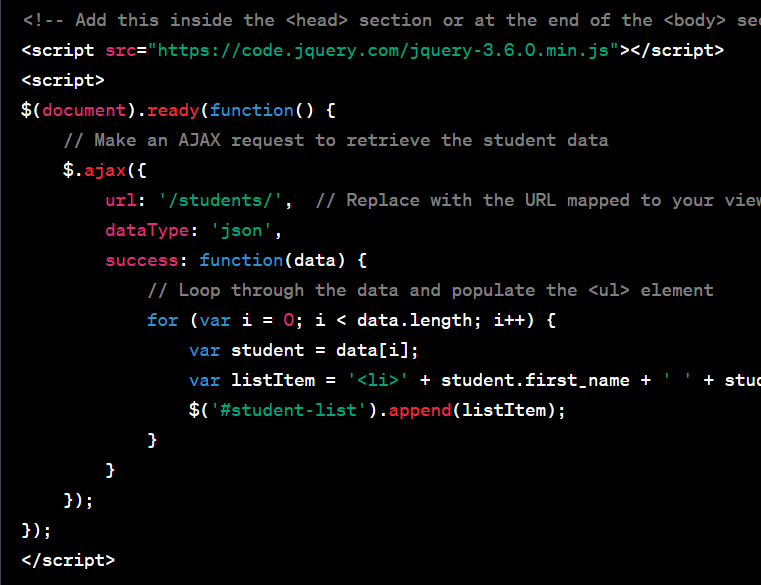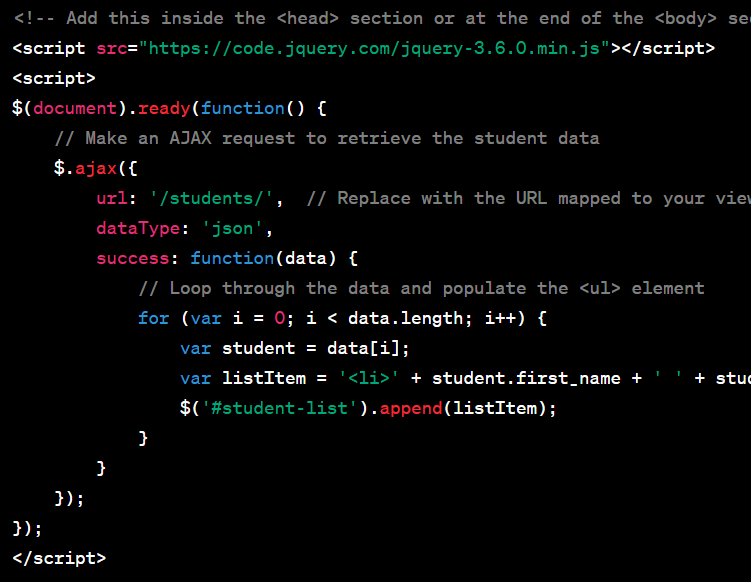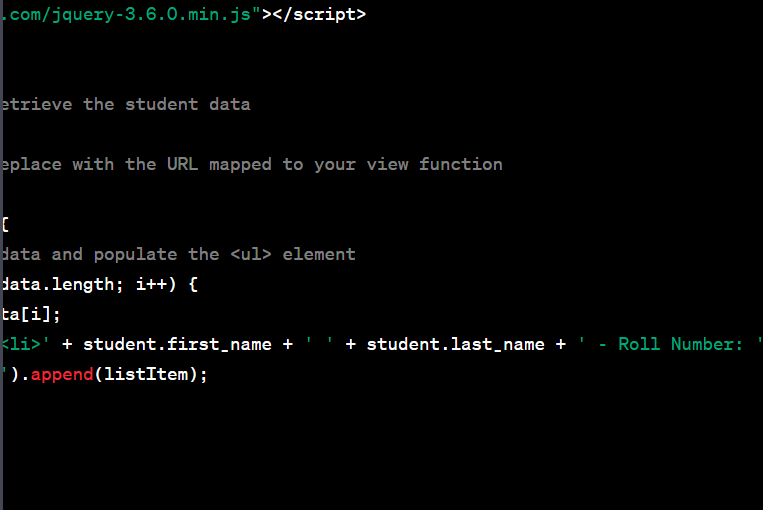To display student data using a JSON response in a template file using jQuery, follow these step-by-step instructions:
Create a view in Django:
Open your Django app's views.py file.
Import the necessary modules and classes.
Create a view function to retrieve student data and return a JSON response.
Example:
from django.http import JsonResponse
from .models import Student
def student_list(request):
students = Student.objects.all().values()
return JsonResponse(list(students), safe=False)
Create a template:
Create a new HTML file called student_list.html in your app's templates directory.
Add an empty
- element to the template to hold the student data.
Example:
<h1>Student List</h1>
<ul id="student-list"></ul>
Add jQuery to the template
Define the URL pattern:
Open your Django project's urls.py file.
Import the view function from your app's views.py file.
Define a URL pattern that maps to the student_list view function.
Example:
from django.urls import path
from your_app.views import student_list
urlpatterns = [
# Other URL patterns
path('students/', student
Using Serializer method
To display student data using a JSON response and jQuery in a template file, follow these step-by-step instructions:
Define the Student model:
Open your Django app's models.py file.
Define the Student model with the required fields.
Example:
from django.db import models
class Student(models.Model):
first_name = models.CharField(max_length=100)
last_name = models.CharField(max_length=100)
roll_number = models.IntegerField()
# Add other fields as per your requirements
Create a serializer:
Create a new file called serializers.py in your Django app's directory.
Import the serializers module from rest_framework.
Define a serializer class for the Student model.
Example:
from rest_framework import serializers
from .models import Student
class StudentSerializer(serializers.ModelSerializer):
class Meta:
model = Student
fields = '__all__'
Create a view:
Open your Django app's views.py file.
Import the necessary modules and classes.
Create a view function to retrieve student data and return a JSON response.
Example:
from django.http import JsonResponse
from .models import Student
from .serializers import StudentSerializer
def student_list(request):
students = Student.objects.all()
serializer = StudentSerializer(students, many=True)
return JsonResponse(serializer.data, safe=False)
Create a template:
Create a new HTML file called student_list.html in your app's templates directory.
Add an empty ul element with an id attribute to the template to hold the student data.
Example:
<h1>Student List</h1>
<ul id="student-list"></ul>
Add jQuery to the template:
<script>
$(document).ready(function() {
// Make an AJAX request to retrieve the student data
$.ajax({
url: '/students/', // Replace with the URL mapped to your view function
dataType: 'json',
success: function(data) {
// Loop through the data and populate the <ul> element
for (var i = 0; i < data.length; i++) {
var student = data[i];
var listItem = '<li>' + student.first_name + ' ' + student.last_name + ' - Roll Number: ' + student.roll_number + '</li>';
$('#student-list').append(listItem);
}
}
});
});
</script>
Define the URL pattern:
Open your Django project's urls.py file.
Import the view function from your app's views.py file.
Define a URL pattern that maps to the student_list view function.
Example:
from django.urls import path
from your_app.views import student_list
urlpatterns = [
# Other URL patterns
path('students/', student





Top comments (0)